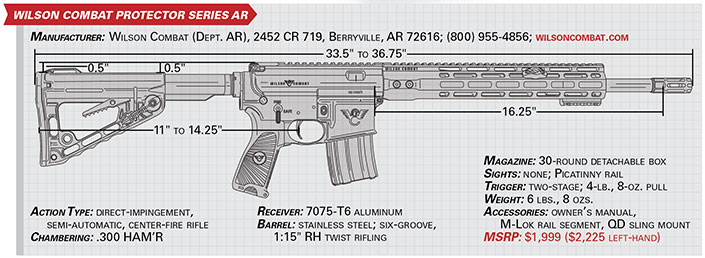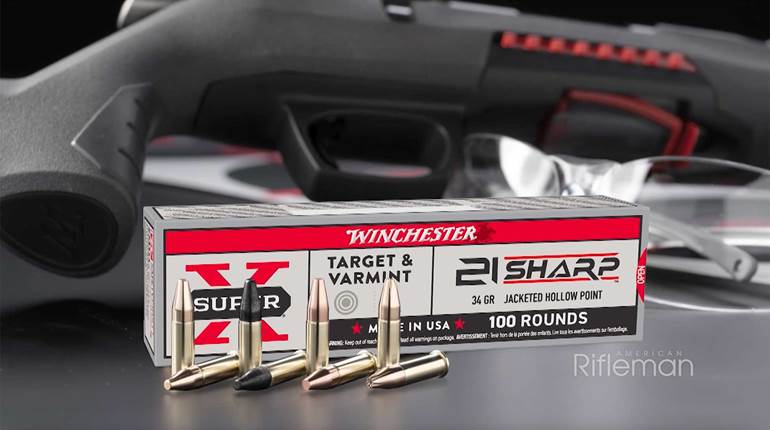
Here at American Rifleman, as the lone lefty presently on staff, all assignments to cover new left-handed guns inevitably end up on my desk, which is perfectly fine with me, as I am a proud advocate for the southpaw minority, and any new firearm options for me and my kind are always a cause for celebration.
So, when I heard that Wilson Combat had introduced a left-hand version of its Protector Series AR, and that I would have the opportunity to venture to Bill Wilson’s private ranch for a field test of a .300 HAM’R-chambered variant of the new carbine on some of Texas’ many feral hogs, I was excited fourfold. Not only that Wilson Combat was joining Rock River, Stag and a few boutique shops on the lonely left-hand AR market, but also that I would have my first exposure to both one of the company’s AR-platform rifles and its newest cartridge (something I had been curious about since the .300 HAM’R’s 2018 launch). Not to mention that I would get to do so while popping some pigs—which I view as one of the most enjoyable civic duties available to mankind.
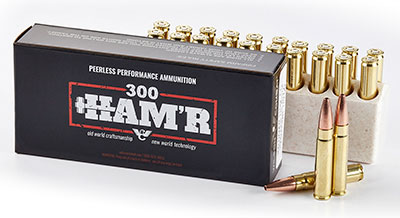
They say that no single gun is the perfect fit for every scenario, and that, as a result, every firearm is an exercise in compromise to some degree or another. This is, of course, correct—my ideal concealed carry choice would no doubt make for a tragically poor safari gun. And given the fact that “they” were almost certainly right-handed, “they” don’t know the half of it, as compromise goes double for us lefties. Like all left-handed shooters, 99 percent of my experience with firearms has been spent making do with guns configured for right-handed use, and for every one model that is at least mostly southpaw-friendly (a remarkable few manage to get it 100 percent correct), there are a dozen with a right-hand-centric manual of arms that puts me at a real disadvantage—whether on the hunt or in the fight.
Bill Wilson is a no-compromise kind of guy. Originally a watchmaker by trade, he only entered the custom firearm business in 1977 after sending some of his own competition guns to well-known gunsmiths of the ’70s and not being overly impressed by the results. He similarly helped found the Int’l Defensive Pistol Ass’n after seeking out a shooting sport that effectively combined competition with a realistic course of fire that tested street-level defensive gun skills and determined the existing options to be lacking. In both cases, he knew he could do better himself.
In light of this, his company’s decision to expand into left-hand models makes perfect sense; southpaw shooters using northpaw guns face an unnecessary obstacle, so why not make it easier for them by removing an aspect of compromise from the equation? Yes, lefties can use right-hand ARs—in point of fact, they’re a good bit more workable for southpaws than are wrong-hand turnbolts—but why would I choose to settle for someone else’s gun when options designed specifically for me exist? Here’s a quick look at the left-hand Protector Series AR and the .300 HAM’R separately, before we see how the combo fared together at the range and against sizeable East Texas swine.

The Rifle
Wilson Combat’s handguns are known for their exacting attention to detail and gorgeous presentations, so I was curious to gauge how much of that meticulousness had been injected into the manufacturer’s rifle production as well. The company introduced AR-pattern rifles to its lineup back in the late 1990s, but the Protector Series is the first to also offer a left-hand SKU. An AR-15-size platform, the Protector is available chambered in .223 Rem./5.56x45 mm NATO and .300 Blackout in addition to .300 HAM’R.
Unlike the rest of the company’s rifle line, which are built on receivers machined from bar stock, the Protector makes use of forged 7075-T6 aluminum receivers, allowing it to be Wilson Combat’s most modestly priced rifle model at a base MSRP of $1,999 (the southpaw version costs a bit more at $2,225). Both receivers are finished with Armor-Tuff—a non-reflective coating that adds lubricity and increases resistance to wear and corrosion—in either black or coyote tan.
Producing a left-hand AR required Wilson Combat to re-design the typical right-hand upper to be a near mirror image of itself in order to facilitate ejection to the left side of the gun. I say “near” because, apart from its reversed nature, the only thing that is truly different about a southpaw upper is that the dustcover flips upward out of the way rather than downward. Internally, left-handed operation also requires the fabrication of a left-hand bolt carrier and a left-ejecting bolt.

Southpaws attempting to hunt with right-hand ARs learn quickly to hate that dang forward assist, as it makes slinged carry of the gun so uncomfortable as to be practically impossible. Sure, ejecting cases no longer whizzing by my face is a nice perk, but moving the protruding forward assist and brass deflector to the other side of the receiver so they don’t dig furrows a little deeper into my spine with every step is one of the largest benefits to a left-hand AR that I’ve come across.
The leftie Protector is built on a standard, right-hand lower receiver, with the right-side magazine release button and left-side bolt release levers in their customary locations. While it would have been nice to see Wilson Combat go the full mile by also utilizing a dedicated left-hand lower on this rifle—which are rare but do exist—to be honest, this is the control scheme that the majority of left-handed AR shooters will be most familiar with anyway. Functionality for southpaws is added by way of bilateral, 90-degree safety selectors on the lower to go with the upper’s Bullet Proof Ambidextrous Charging Handle. I install Magpul B.A.D. Levers on all of my ARs, regardless of which direction their ejection ports are pointed—to give me easy access to the bolt release without the need to abandon my shooting grip—so I’d personally just throw one of those onto the Protector and consider it optimized.
Although a pistol version of the direct-impingement Protector is also offered, the gun I shot on my hog hunt (and the sample used in subsequent testing) was a carbine with a 16.25" stainless steel barrel and a mid-length gas system. Attached to the muzzle via 5/8x24 TPI threading is a Wilson Combat Q-Comp muzzle brake. The aluminum free-floating handguard is a 12.6"-long octagonal unit with a full-length Picatinny rail at the 12-o’clock position and at least five M-Lok-compatible slots on each of the seven remaining sides; standard with the Protector are a 4" accessory rail and a QD sling mount for use with the handguard.
Completing the gun’s furniture are a Rogers Super-Stoc buttstock, attached to the lower by way of a carbine-length receiver extension, and a BCM pistol grip bearing Wilson Combat’s distinctive starburst pattern. The former is capable of being adjusted to six length-of-pull settings, with a cam lever that can be used to secure the stock in place once the desired length has been reached, as well as an integral sling loop and QD sling mount. The latter’s sunbeams each bear moderately coarse texturing that very effectively serves to anchor the rifle in the hand during use, without being at all painful, and a water-resistant storage compartment is housed within the grip’s toe.
The trigger included with the Protector carbine is the company’s M2 Tactical Trigger Unit, a two-stage trigger advertised to have a crisp break at between 4 lbs. and 4 lbs., 8 ozs. of pressure, and our sample tested at exactly the outside limit of that range. And I have to admit, the break is the kind of glass-rod crisp that shooters dream about, on par with aftermarket drop-in triggers that can cost up to $300 on their own. One 30-round magazine from D&H Tactical shipped with the gun, and although it was marked for use with .300 Blackout, it ran the .300 HAM’R without any objection.
Overall build quality of the rifle was superb; no tooling marks were apparent, and the Armor-Tuff finish appeared to have been evenly applied. The components used on this gun all fulfilled their functions admirably, but, in my opinion, the trigger and charging handle are worthy of special praise. I evaluate a lot of ARs, and I don’t recall ever working with a finer trigger in a straight-from-the-box rifle. And, as a lefty, the Bullet Proof charging handle is among the better ones that I’ve encountered—sized right to be easy to actuate with either hand while remaining unobtrusive. In all, I was not at all disappointed by the Protector Series AR—even in light of its premium price tag—and as you’ll see below in a moment, there’s no compromise offered by its performance in the field or on the range either.
The Cartridge
Bill Wilson has been cooking up the .300 HAM’R for a long time—even long before he really became aware of it. As a consummate hunter who just so happened to also own his own AR-manufacturing company, he has harvested countless animals with the rifles, and maximizing the compact AR-15 platform’s ballistic potential in particular—against both beast and man—has always been a personal quest of his.
Much of his early AR hunting was conducted with the 6.8 mm SPC cartridge, but Bill has always been a “bigger bullets are better” kind of guy, and he quickly moved up to the .30 caliber for the heavier projectile weights it provides. He then dabbled briefly in the available options, the .300 Blackouts and .30 Rem. ARs of the world, before ultimately deciding to develop his own cartridge—one that would match the terminal performance of the legendary .30-30 Win. while retaining the .223 Rem./5.56 mm NATO AR-15’s standard bolt and the ample capacity made possible by its slender profile.

Wilson Combat had introduced the Kurt Buchert-designed 7.62x40 mm WT—a .30-cal. cartridge similarly designed for compatibility with .223 AR parts—back in 2011, and Bill’s project (tentatively dubbed “.30-30AR”) began there. The 7.62x40 mm WT is a .223 Rem. necked-up to use 0.308" bullets that maintains a Cartridge Overall Length (C.O.L.) that permitted its use within AR-15-size magazines and actions, and while Bill liked much that it had to offer, he wanted his cartridge to boast a greater powder capacity and correspondingly faster velocities.
He accomplished this by lengthening the throat—and the case in general—slightly, decreasing the rate of the case’s taper and adjusting the angle of the neck to 30 degrees, changes that not only increased case volume, but also lowered operating pressures. The resulting cartridge bears a maximum C.O.L. of 2.26" and a case head measuring 0.378" in diameter, figures that are both identical to those of the .223 Rem., with a maximum average pressure of 57,500 p.s.i.—relatively close to .223’s 55,000 p.s.i. specification. And the case’s narrow diameter, measuring 0.3759" at its widest point (just forward of the extractor groove), allows .300 HAM’R cartridges to stagger comfortably within a typical double-stack AR-15 magazine with no decrease in capacity relative to .223 Rem. Compatible with standard .223 AR parts after a simple barrel change? Check.
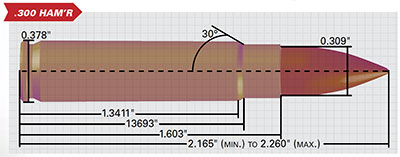
Rigorous testing using numerous propellants and barrel twist rates determined that the best velocity and accuracy results were produced by Hodgdon’s Cfe Blk powder and a 1:15" twist rate, respectively. Wilson Combat asserts that the end result not only reaches .30-30 Win. performance but eclipses it—a claim we will put to the test shortly. The .30-30AR moniker was eventually dropped when Bill’s son Ryan recommended the use of “.300 HAM’R,” as Wilson Combat had already previously introduced the .458 HAM’R, and had trademarked the suffix at that time.
The cartridge launched in 2018, and is now an option in any of Wilson Combat’s AR-15-size models. In 2019, SIG Sauer sponsored .300 HAM’R for induction into the Sporting Arms and Ammunition Manufacturers’ Institute—the organization that creates industry standards to ensure the safety, reliability and interchangeability of firearms, ammunition and components—and in early 2020 the cartridge was officially accepted and its specifications were published.
Bill’s original .300 HAM’R load used a 125-gr. Sierra projectile, but the Wilson Combat website presently lists 20 ammunition options (18 loaded by the company itself and two by HSM) topped with bullets ranging from 95 to 150 grs. in weight—a number of the lighter of which could make for potent manstoppers, in addition to the heavier hunting options. Velocities obviously vary greatly depending on the weight of the projectile, but according to the figures provided by Wilson Combat, the muzzle energy of the various loads hovers between 1,650 and 1,820 ft.-lbs. through an 18" barrel. According to Bill, 18" is probably optimal for .300 HAM’R, but a 16"-barreled gun still provides plenty of performance out to several hundred yards for the taking of game up to the size of bull elk and the largest plains game that Africa has to offer.

The Results
Bill Wilson is more than willing to trot the globe in search of exotic quarry; since completion of .300 HAM’R, he has used the cartridge to down everything from whitetail deer and elk to oryx, hyena and kudu. But he has a special love for hunting hogs—and he doesn’t even have to leave his own property in order to do so. Having completed the heavy lifting of building a company from the ground up and founding the IDPA decades ago, he now works mostly from the confines of his ranch in rural northeast Texas, stepping outside to hunt whenever the mood strikes him—which is frequently. In his own words, he “only hunts hogs on days that end in ‘y,’” and while that might be a slight exaggeration, I can assure you, it’s not by much.
Whenever possible, I try to complete function and accuracy testing of a gun prior to its use in the field, but that’s not always feasible, and so it was that I found myself in early March taking my first shots through the .300 HAM’R Protector during some familiarization firing prior to that night’s hunt. For the following three days and nights, two other hunters and I crisscrossed Bill’s property countless times in search of pigs, our magazines filled with Wilson Combat’s 150-gr. Hornady SST-topped load, and our rifles equipped with the company’s .30-cal. Whisper suppressor. Examples from both Pulsar’s Trail and Thermion lines of thermal-imaging riflescopes were employed once the sun went down.
In all, the group shot nine large boars, and I personally accounted for three—two at night and one during the day—taking more than 650 lbs. of Texas’ hog problem out of commission. The largest of mine was a disgusting 224-lb. bruiser so flea-ridden that even the other pigs wanted nothing to do with him. Shots ranged from about 30 to 150 yds. in mostly thickly forested terrain, and while we didn’t take the time to retrieve any bullets, the cartridge proved to be more than up to the task of quickly anchoring the hearty beasts. No animals were lost, the majority were one-shot kills, and .300 HAM’R dropped more than one in its tracks. We also shot the carbines on Bill’s private long-range course, and even out at 500 yds. the HAM’R was still whacking the steel with authority, the guns consistently putting accurate shots on target.
Back home on the range, shooting three Wilson Combat loads (including the one used to great effect on the pigs), the .300 HAM’R-chambered Protector proved itself to be highly accurate and 100 percent reliable. In the field we hunted with our scopes set on 6X, so this was the magnification I used during testing as well—in order to get a true sense of its practical accuracy. Using five-shot groups, the 130-gr. Speer HAM’R Hot-Cor produced the best five-group average at 100 yds. (1.14"), while the 125-gr. Sierra Pro-Hunter turned in the single tightest group of the day, a 0.38" beaut of a one-hole cluster. These results are far better than would be required in either a defensive or a short-to-medium-range hunting role.
Chronographing the three loads revealed that they lost very little velocity (roughly 40 f.p.s.) through a 16.25" barrel relative to the 18" numbers posted on their boxes, and still averaged about 1,735 ft.-lbs. of energy 15 ft. from the muzzle. That is an exemplary amount of firepower for the AR-15 platform—even more so from a handy carbine—surpassed only by big-bore “Thumper” cartridges capable of far lower capacities than is the .300 HAM’R. But does it rise to the level of the good ole’ .30-30 Win., as was the project’s goal?
People get real ornery when you compare something new and unknown with something old and cherished, and a lot of people shot their first deer with a .30-30 Win., so the cartridge has no shortage of nostalgic devotees. Sorry guys, prepare to be vexed—because through barrels of equal length, the .300 HAM’R did, indeed, produce higher energies than did two of the three .30-30 loads that I chronographed. Using a Marlin 336 Dark, Hornady’s 160-gr. LEVERevolution ammunition did best the .300 HAM’R with an average result of 1,795 ft.-lbs. of energy at 15 ft. from the muzzle, but both Federal’s 150-gr. Power-Shoks and Winchester’s 170-gr. Power-Points generated considerably less energy (1,670 ft.-lbs. and 1,552 ft.-lbs., respectively) at that distance. And, of course, the AR platform’s use of a detachable box magazine allows the .300 HAM’R to take safe advantage of spitzer-point projectiles with higher ballistic coefficients and flatter trajectories than nearly any .30-30 loads can muster.
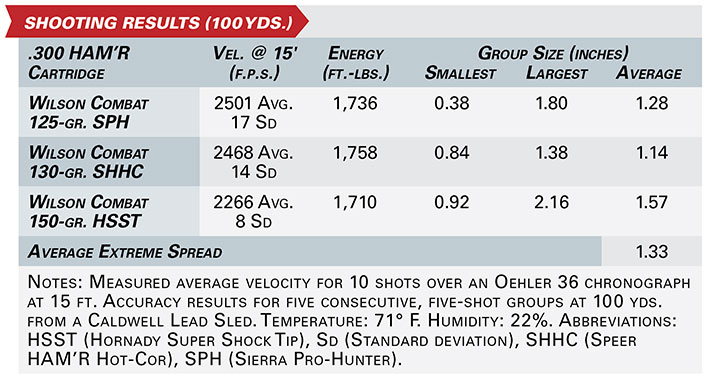
On the range, recoil of the .300 HAM’R is ever so slightly more than that of a .300 Blackout, and is probably most comparable to 350 Legend. It nowhere near approaches a level where it might impair your ability to get off a clean shot. In the field, benefiting from the recoil-attenuating attributes of a suppressor, recoil was inconsequential and off-hand follow-up shots were immediate.
No single gun may be the ne plus ultra for all scenarios, but the Wilson Combat Protector Series AR carbine chambered in .300 HAM’R is a fine choice for a great many of them—from home defense to the taking of all North American game. And that goes for left-handed shooters too, as while the AR pattern in its stock, mil-spec configuration may not be set up particularly well for lefties, the southpaw Protector puts everything where it needs to be.
The only restricting factor to this setup is that, up to this point, Wilson Combat has essentially been the only source for .300 HAM’R ammunition and rifle components, a reality that has greatly limited their availability—but it looks like those days are over. Shaw Barrels recently announced that it has begun offering barrels, complete uppers and finished rifles chambered for the cartridge, and I know of at least one of the major ammunition makers that is currently working up loads. Here’s hoping its recent adoption by SAAMI helps the cartridge continue to gather momentum with manufacturers and consumers alike, because it’s an impressive chambering that—between its formidable terminal performance and ample capacity—comes as close to maximizing the AR-15’s total onboard firepower as anything developed to date.
